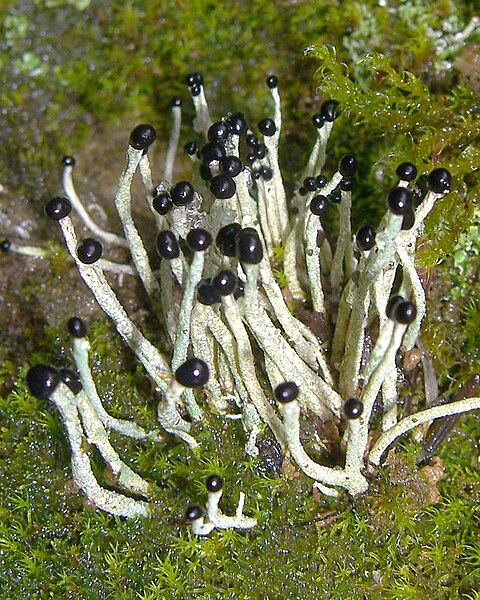The Cladoniaceae are a family of lichen-forming fungi in the order Lecanorales. It is one of the largest families of lichen-forming fungi, with about 560 species distributed amongst 17 genera. The reindeer moss and cup lichens (Cladonia) belong to this family. The latter genus, which comprises about 500 species, forms a major part of the diet of large mammals in taiga and tundra ecosystems. Many Cladoniaceae lichens grow on soil, but others can use decaying wood, tree trunks, and, in a few instances, rocks as their substrate. They grow in places with high humidity, and cannot tolerate aridity.
Cladoniaceae
In Cladonia coccifera, the conidia are embedded in a scarlet-coloured slime on the margins of the scyphi (cups).
Pilophorus acicularis
Pycnothelia papillaria
A lichen is a symbiosis of algae or cyanobacteria living among filaments of multiple fungi species, along with a yeast embedded in the cortex or "skin", in a mutualistic relationship. Lichens are important actors in nutrient cycling and act as producers which many higher trophic feeders feed on, such as reindeer, gastropods, nematodes, mites, and springtails. Lichens have properties different from those of their component organisms. They come in many colors, sizes, and forms and are sometimes plant-like, but are not plants. They may have tiny, leafless branches (fruticose); flat leaf-like structures (foliose); grow crust-like, adhering tightly to a surface (substrate) like a thick coat of paint (crustose); have a powder-like appearance (leprose); or other growth forms.
A tree covered with leafy foliose lichens and shrubby fruticose lichens
Letharia vulpina, wolf lichen, grows like a multiple-branched tuft or leafless mini-shrub, so it has a fruticose growth form.
Flavoparmelia caperata has leaf-like structures, so it is foliose.
Caloplaca marina grows like an orange crust coating the rock, so it is crustose.








